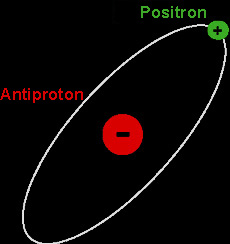


Schematic of a Penning trap: an appropriate configuration of electric and magnetic fields traps charged particles in a small volume.
ATRAP
If physicists at the AD experiments will be able to trap and study "cold" (= low energy!) antiprotons, it is thanks to the work of TRAP, a former (1986-1999) CERN experiment which, at LEAR , developed the techniques for slowing, cooling and storing antiprotons. When LEAR closed and the AD took its place, TRAP grew into ATRAP.
The goal of ATRAP is to produce cold antihydrogen atoms and use laser spectroscopy to check, with very high accuracy, if the properties of antihydrogen and hydrogen atoms are the same.
Why antihydrogen atoms?
Antihydrogen is the simplest antimatter atom; it consists of a positron orbiting around an antiproton. It is the antimatter counterpart of the hydrogen, the simplest matter atom, in which an electron orbits around a proton.
How are they planning to do it?
To reach their goal, ATRAP physicists have two main steps to accomplish : they have to build the antiatoms first, and then be able to store them for a period long enough to perform all the required measurements.
For step one, ATRAP will use the world's most intricate Penning trap structure, able to accumulate antiprotons coming from the AD and positrons originating from a radioactive source at the same time.
The trap consists of a long series of gold-plated electrodes, cooled to 4 degrees above absolute zero (-269 degrees Celsius!)and located within a very strong (6 Tesla) magnetic field.
|
(ATRAP
- page 1 of 2)
| Next > |

